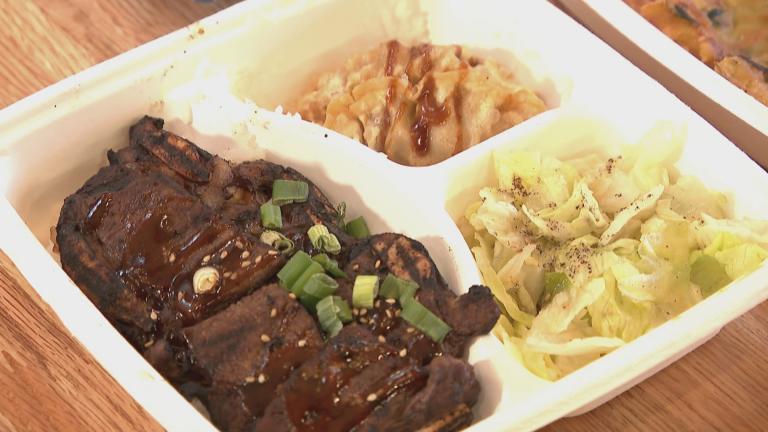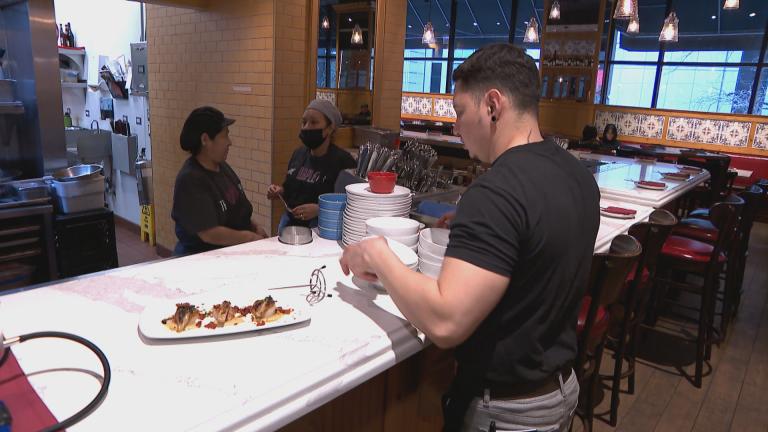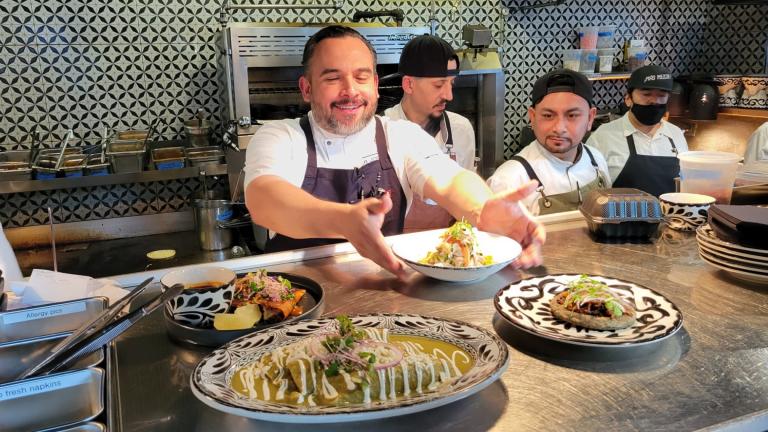As a grill cook at Logan Square restaurant Fat Rice, Travis Champer used to take home less pay than servers. That’s because servers get tips from customers on top of their hourly pay, and back-of-house staff – like Champer – don’t, even though they may have similar hourly wages.
That wage disparity is not unique to Fat Rice. It’s a well-known characteristic of large and small restaurants across the country, Champer said.
But that’s changing at Fat Rice and its adjoining spaces The Ladies’ Room and The Bakery at Fat Rice, all thanks to a new initiative by chefs and co-owners Abe Conlon and Adrienne Lo.
Since its implementation Jan. 1, the “Fair Wage and Wellness Provision” is so far adding a 25-percent increase to paychecks of Champer and other non-tip staff. And while there have only been two pay cycles since the beginning of the year, Champer said he already sees the difference.
On top of increased pay to level out the wages of back- and front-of-house staff, the provision allows Conlon and Lo to offer employees health insurance.
 Cocktail lounge The Ladies’ Room adjoins Fat Rice restaurant, where co-owners Abe Conlon and Adrienne Lo have implemented a surcharge to customers’ checks. (Courtesy of Francis Son)
Cocktail lounge The Ladies’ Room adjoins Fat Rice restaurant, where co-owners Abe Conlon and Adrienne Lo have implemented a surcharge to customers’ checks. (Courtesy of Francis Son)
The new benefits – increased wages and health care – are made possible by a 4-percent hospitality provision, or surcharge, that’s applied to customers’ checks before tax. For example, a bill that comes out to $100 will be $104 with the surcharge.
It’s “a clear and transparent way of us raising prices and directing that money directly to our employees,” Conlon said, adding that information about the surcharge is available on the restaurant’s website and in a detailed letter handed to every customer before they order food.
Poll: Should more restaurants implement a surcharge to raise wages and offer health care?
Servers are also trained to explain the provision to guests, he said.
Fat Rice isn’t the only restaurant making use of a surcharge. It’s a growing development in cities like Boston – where Conlon said he did research before implementing the provision at his own restaurant – and in other Chicago hot spots like Giant and Daisies.
Since opening Fat Rice six years ago, Conlon said he and business partner Lo tried different methods and theories to help minimize the wage gap and offer health insurance to full-time employees, but the co-owners didn’t find a solution that addressed income inequality.
 Chefs and restaurant co-owners Abe Conlon and Adrienne Lo have implemented a new provision at their Logan Square restaurant, which they hope will cover costs to provide health insurance to their employees. (Courtesy of Maria Ponce)
Chefs and restaurant co-owners Abe Conlon and Adrienne Lo have implemented a new provision at their Logan Square restaurant, which they hope will cover costs to provide health insurance to their employees. (Courtesy of Maria Ponce)
Increasing menu prices would only increase tips for servers and discourage customers from “voicing their opinions on how their dining experience went – with their wallet,” Conlon said. And sharing tips across all employees could help diminish income inequality, but it wouldn’t contribute to fair wages for salaried employees.
“We at this juncture feel this is the best way forward,” Conlon said. “We’re not saying it’s a perfect solution, but it’s definitely a solution for us to reward our back-of-the-house employees who work very hard, and to also retain and attract quality talent in an ever diminishing talent pool that is not only in Chicago, not only in the United States, but across the world.”
Conlon said in Chicago and elsewhere, attracting and retaining talent in independently owned and operated restaurants is becoming a struggle. He said some employees – including some of his own in the past – choose to work with a hotel or restaurant group that has larger profit margins, which helps supplement higher wages and health insurance.
Fat Rice sees a 5-percent profit margin “if we’re lucky,” Conlon said.
That’s not unusual, said Sam Toia, president and CEO of the Illinois Restaurant Association.
“The average restaurant makes between 3- to 5-percent profit,” he said. “And for many of the small operators, it’s even tighter. So you have to find creative ways for employee retention and health insurance.”
In addition, there are only two things a restaurant owner can control, Toia said: payroll and product cost.
Conlon said he and Lo are not interested in cutting costs.
“That’s our service to our customers – using natural, organic products whenever possible and really just focusing on local farmers and things like that,” he said.
 Pig Bun pastries at The Bakery at Fat Rice. (Courtesy of Fat Rice)
Pig Bun pastries at The Bakery at Fat Rice. (Courtesy of Fat Rice)
But some, like Bob Goldin, senior partner and co-founder of Pentallect Food Industry Consultants – which focuses on business strategy for food service companies and restaurant chains – thinks many customers might feel like the surcharge is another tax on their dining experience.
“I’m 100 percent in favor of providing health care,” he said. “But I think a lot of consumers will say, ‘It’s the restaurant’s responsibility.’ And remember – when you go to a restaurant, you’ve got tax, tip, maybe coat check and parking … It just adds to the cost. It’s another burden on the consumer.”
But Conlon said customers have been responding positively to the surcharge.
“I think a lot of people do understand that back of the house works as hard as the front of the house, that they need to get paid more and that having access to health care is a good thing,” he said.
As for employees like Champer, being a part of a new restaurant development is exciting.
“I think this is something that many people in the restaurant industry long thought and talked about, but I’m now getting to see it put into place and I get to be a part of it,” Champer said.
Related stories:
Remembering Chicago’s ‘Lost Restaurants’
Heartland Cafe in Rogers Park Prepares to Close After 42 Years
Critic Who Dissed Chicago’s Food Scene Defends His Article








